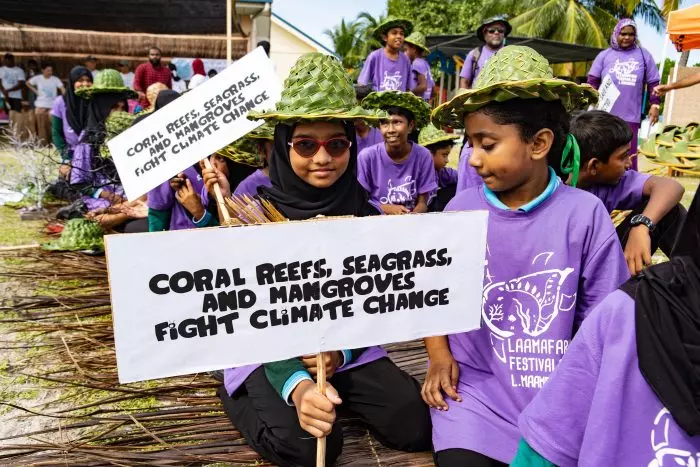LAAMAFARU FESTIVAL – A TESTAMENT TO THREE YEARS’ HARD WORK
October 09, 2019 by Vivienne Evans

The Maldives holds a special place in my heart. I have worked in the country for more than three years and lived here for one and a half of those. I am unbelievably fortunate that I still get to return to Laamu Atoll, where BLUE’s base is, to visit Shaha, BLUE’s Laamu Project Manager, and the rest of the team at Six Senses Laamu. This year, I was lucky that my visit happened to coincide with the annual community festival held by Six Senses Laamu and its local partners.
The festival has been running for three years and is the only annual event where more than 1,000 people from Laamu gather together to celebrate their environment. This year’s festival was named “Laamafaru” (meaning the reefs of Laamu in the local language, Divehi) to reflect the importance of coral reef protection for the Maldives in the face of climate change.
On the morning of the festival, everyone breathed a sigh of relief as the sun came out after more than a week of non-stop rain. As we made our way over to the local island of Maamendhoo, it was evident that there was already a buzz on the island. More than 700 school students and some 500 other residents of Laamu were busy arriving on boats from the ten other inhabited islands in Laamu. Some of them had travelled as far as 40 km across the Atoll to attend the event.
We were welcomed to the festival by a large handmade arch reading “Our Ocean – safe and protected” decorated with eagle rays, sharks, turtles and jellyfish. Sounds from the local “Boduberu” group (traditional Maldivian drumming) filled our ears and some adorable young girls dressed head to toe in traditional red Maldivian dress known as “libaas” greeted us.
Aishath Rafa Nazim, a local celebrity, opened the event by calling on everyone to become ambassadors for environmental protection in the Maldives, stressing how important coral reefs and their connected habitats, seagrass and mangroves, are for the Maldives.
Speaking to festival goers, Aishath said, “We have to stand up and act to protect our environment. Our coral reefs are our protection from waves. They support our fisheries, attract tourists and bring in money to sustain our economy. They are also our main source and nutrition of our food. So, conservation of this natural habitat is crucial, and we know that if we act responsible and with respect we can continue to benefit from our ocean and its surrounding habitats.”
Shortly after, the festivities began. Students from each school paraded around the central area dressed in their colourful Laamafaru festival t-shirts, proudly carrying their magnificent handmade sea creatures made from palm leaves, while clutching climate strike signs reading “ACT NOW OR SWIM LATER” and “THE MALDIVES IS 99% SEA, WHY CAN’T YOU SEE!”.
Later, each school acted out short plays about Laamu Atoll centred around the theme of protecting the environment. One play explained how the children of Maamendhoo had learnt not to throw plastic in the sea thanks to the marine biologists from Six Senses Laamu. One child even dressed up in the blue resort marine biologist uniform!
The afternoon was no less exciting as kids ran around throwing giant dice, playing the protected areas snakes and ladders game and pretending to catch fish while learning about which are legal according to Maldivian law. As the day ended, at least 20 students – including girls who are typically not encouraged to swim as much as boys – jumped into the water for a much needed cool-off in the form of an inter-school swim race.
It’s hard to put my finger on what was different this year, but something has shifted. Perhaps it was the festival’s new focus. Perhaps it was the community of Maamendhoo who took such ownership of the festival and showed such enthusiasm and pride in everything they did. Or perhaps it was the joy on everyone’s faces and the laughter being shared between individuals from schools, resorts, NGOs and the government, which seemed more genuine than ever before. Perhaps it was all of the above.
As I watched the festival-goers enjoying themselves, it dawned on me just how long we have been working in the area and how many connections and friendships we have made during this time.
When Shaha and I started out in 2016, there were only two resort marine biologists and two Manta Trust staff who would occasionally visit the school on Maamendhoo. Only one third of the team was Maldivian. Three years later, eleven marine biologists make up the Maldives Underwater Initiative team (a coalition of three NGOs and resort staff) and almost half of the team is Maldivian.
Over the span of three years, we have done educational sessions with every school in the Atoll (often more than once), held open forums for communities, worked with over 150 fishermen, and taught more than 400 children how to snorkel.
Professor Yvonne Sadovy, who was visiting Laamu, said: “Real conservation takes a decade, at least, because it’s about changing people’s mindsets and building relationships and trust with one another”. I realised that what I was experiencing at the festival was a community in Laamu Atoll whose members trust one another and want to work together for the good of their shared environment.
BLUE and its partners are supporting the Laamu Atoll Council and the people of Laamu to develop the first marine reserve in the Atoll. We are confident that our grassroots approach will translate into long-lasting and meaningful conservation for the Maldives. We look forward to working together with our friends and colleagues on Laamu to secure a better future for nature and Maldivian people.

